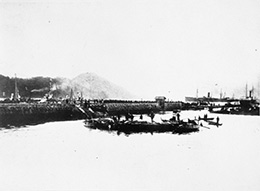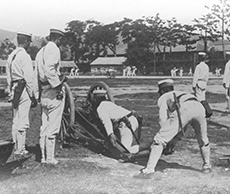The Heart of a Military City - 1
The First Outpost of Kyushu Garrison was established within the Honmaru of Hiroshima Castle in 1871, soon becoming the Hiroshima Garrison of Fifth Military District in 1873 and then the Fifth Division in 1888, and the number of military personnel in Hiroshima was gradually strengthened. The 11th Infantry Regiment and the Transport Corps, who were responsible for transporting military items, were formed and Moto-machi eventually filled in with military-related facilities. Although it must appear that Moto-machi was the center of the military city of Hiroshima, it was also a fun and relaxing place where citizens could enjoy themselves and feel at ease.

Hiroshima Garrison Headquarters building
In January, 1873, the country was divided into 6 military districts and the Fifth Military District’s garrison was placed in Hiroshima. In 1877, the main building of the Hiroshima Garrison Headquarters was built within the Honmaru of Hiroshima Castle. From 1888, this building was used as the Fifth Division Headquarters and was used during the Sino-Japanese War in 1894-1895 as the Imperial Headquarters, housing the supreme military command.
Early Meiji Period Collection of Hiroshima Castle

Hiroshima Eiju Hospital
Originally constructed in 1871 on the Takenomaru of Hiroshima Castle, the first incarnation of the garrison hospital was later moved within the fortress walls and then to the Nishinomaru in 1885 where it became the Eiju Hospital.
Collection of Hiroshima Municipal Archives

Transport ships anchored in Ujina Port and small crafts carrying dispatched troops
During the Sino-Japanese War, Ujina Port became a military transport base connecting Japan and the Asian continent, and it was from here that many soldiers left for the frontlines.
Courtesy of Japanese History Research Room, Graduates School of Letters, Hiroshima University

Artillery training
Soldiers from the 5th Field Artillery Regiment training on the Western Drill Ground in the Otekuruwa on the castle’s south side.
Around 1905 Collection of Hiroshima Castle

The recently completed Ujina Line
After the Sino-Japanese War had begun, the Ujina Line, a military railway for transporting troops, was laid between Hiroshima Station, the western terminus of the Sanyo Railway, and Ujina Port.
Courtesy of Japanese Red Cross Society

Expansive Military Reservation
Before the Sino-Japanese War, the military reservation within the city was limited to the area within the castle walls and places such as the Eba Firing Range and the Eastern Drill Ground, but the Sino- and Russo-Japanese wars led to a large-scale expansion. Additional facilities included the Army Transport Division and their factory on Kanawajima Island; depots for army provisions, clothing, and ordnance; and the Ninoshima Quarantine Station. These additions almost doubled the size of military-use land in the city.
Source: Hiroshima History New Edition, Vol. 2
*Click the map to see a larger image.
